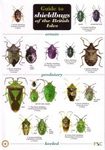Identification Key Monograph
By: Randall T Schuh(Author), Christiane Weirauch(Author)
800 pages, 32 plates with colour photos; 182 b/w photos and b/w line drawings
![True Bugs of the World (Hemiptera: Heteroptera) True Bugs of the World (Hemiptera: Heteroptera)]()
Click to have a closer look
About this book
Customer reviews
Related titles
About this book
The first edition of True Bugs of the World presented a comprehensive review of heteropteran biology, morphology, and classification down to the subfamily level. In the intervening 24 years our knowledge of the Heteroptera has vastly increased. Almost 5000 new bug species have been described during this period, a 12–15% increase. Two new families, Curaliidae and Meschiidae, have been described, and the categorical rank of multiple family-group taxa has been revised. The use of cladistic methods through the application of more-user-friendly computer programs and of DNA-sequence data in phylogenetic analysis are now commonplace with a concomitant increase in our understanding of true-bug relationships. The study of fossil Heteroptera has blossomed in a way not seen since the late 19th and early 20th centuries. Finally, a large body of literature now documents various aspects of the natural history of true bugs, ranging from chemical ecology to microbiomes, and establishing certain Heteroptera as model organisms for phenomena including aposematism, sexual conflict, and paternal care. All of these factors argued for an updated volume summarizing our general knowledge of the true bugs.
In preparing this second edition, Randall Schuh and Christian Weirauch (the latter a new author for this edition) have maintained an organization approach similar to that of the first edition. The introductory chapters deal with issues from a historical and functional perspective, the major alteration of format involving the coalescence into a single chapter of all material dealing with heteropteran natural history. Following a key to infraorders, they present for the first time an extensive review of fossil Heteroptera. The systematics chapters, which comprise the remainder and preponderance of the work, focus almost exclusively on living Heteroptera. Taxa are grouped by infraorder, superfamily, family, subfamily, and in some cases tribe.
Following from the first edition, the authors present diagnoses and information on the history of classification for suprafamilial taxa, all families, and for many subfamilies and tribes, as well as sections on specialized morphology, natural history, and distribution and faunistics. They continue to present information on numbers of described taxa. True Bugs of the World includes figures for general morphology and for details of structure in all family-group taxa, as well as 32 colour plates of habitus images and 2 of living bugs; 3020 papers are cited, a 230% increase over the first edition. The majority of the newly cited papers have been published since 1993 when the literature search for the first edition stopped. This seminal volume will appeal to anyone interested in Heteroptera, including for use as a general reference, specialized textbook, aid to family-group identification, and a gateway to the ever-expanding literature on the group.
Customer Reviews
Identification Key Monograph
By: Randall T Schuh(Author), Christiane Weirauch(Author)
800 pages, 32 plates with colour photos; 182 b/w photos and b/w line drawings


















![Die Wanzen Deutschlands, Teil 1: Bestimmungsschlüssel für alle Familien und Gattungen [The Bugs of Germany, Volume 1: Identification Key for all Families and Genera]](http://mediacdn.nhbs.com/jackets/jackets_resizer_medium/24/246860.jpg?height=150&width=107)


![Faune de France, Volume 77: Hémiptères Saldidae et Leptopodidae d'Europe Occidentale et du Maghreb [Hemiptera Saldidae and Leptopodidae from Western Europe and the Maghreb]](http://mediacdn.nhbs.com/jackets/jackets_resizer_medium/34/34077.jpg?height=150&width=98)
![Hémiptères de France, de Belgique, du Luxembourg et de Suisse [Hemiptera of France, Belgium, Luxembourg and Switzerland]](http://mediacdn.nhbs.com/jackets/jackets_resizer_medium/22/226274.jpg?height=150&width=106)
![Tentōmushi: Getcho Sensei no Tentoumushikorekushon [Ladybirds: Mr. Getcho's Ladybird Collection]](http://mediacdn.nhbs.com/jackets/jackets_resizer_medium/26/264269.jpg?height=150&width=108)











